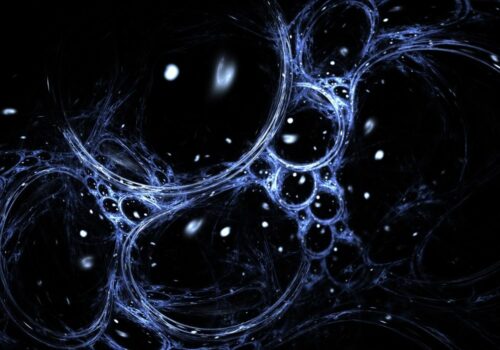Image courtesy of Livescience.
Dark matter is known to permeate our universe, but its exact nature has long remained a mystery. Now, new research from the Wright Laboratory at Yale sheds light on the presence of dark photons, a candidate for dark matter. The team, led by Sumita Ghosh, a graduate student in applied physics at the Wright Laboratory, developed new methods of analyzing existing data sets from devices known as haloscopes, which have previously been used to detect particles known as axions. This new method of detecting dark photons could help answer long-standing questions about dark matter.
Ghosh says that she had previously read about dark photons but had not studied them in her research before. Her greatest motivation, she says, coincided with the pandemic. “I couldn’t do my regularly scheduled work anymore,” Ghosh said. Thus, she decided to focus on this project, whose work combines algebra, probability, and coding, all of which she could do at home. Ghosh was inspired by previous research on dark photons, including two studies in particular: one by Arias et al. on WISPy Dark Matter, and another by Caputo et al., “Dark photons: a cookbook.” “[The Caputo paper] is absolutely brilliant,” said Ghosh, “and inspired me to do a more rigorous job on one of the experiments [she analyzed], the CAPP haloscope.”
This research is part of an ongoing scientific investigation into the nature of dark matter. Previous astrophysical observations indicate that around 85 percent of the matter in the universe is dark matter, the nature of which is still, for the most part, unknown. However, most of the previous research in dark matter has pointed to certain characteristics of dark matter: it is massive, stable, and manifests primarily through interactions with the observable universe, particularly gravitational interactions.
One candidate for the basic, or elementary, dark matter particle is the axion, which is detected using detectors known as haloscopes. A haloscope is a device made of a strong magnetic field in a microwave cavity, within which we search for signals matching the range of axion frequencies. Haloscopes can also detect the presence of dark photons, which are another dark matter candidate. Not much is yet known about dark photons, but according to Ghosh, they are a possible “flavor” of the photon and the mediator of a “dark electromagnetic force.”
“All particles in particle physics have parameters, including mass, charge, and other properties with a numeric value,” said Ghosh. Particles such as axions and dark photons, which we know less about, have is a range of possible values for each property. The combination of these ranges in vector form is known as the parameter space. This study describes a procedure to convert haloscope data from axion parameter space into dark photon parameter space, thus allowing for more potential detection of dark photons using haloscopes.
Dark photon fields can be uniformly or non-uniformly polarized, both considered in this study. “The method outlined in this work for using a single cavity haloscope as a dark photon detector may be applicable to any haloscope that employs a similar analysis procedure,” Ghosh said. Regarding the viability of the dark photon as a dark matter candidate, they have several mechanisms that allow them to naturally produce relic abundance – which refers to the amount of a particle that is still around after the Big Bang – of dark matter. However, Ghosh said, “the motivation for dark photons is not contingent on their comprising all of dark matter.”
This research is significant because there are many materials that dark matter could consist of, each of which has a large parameter space. “It’s important to try to narrow that down faster than we’re currently able to,” said Ghosh. “Each experiment built is so expensive, and it would be amazing if we could make them all more productive by being able to interpret the same data in many different ways.” Ghosh also noted that, since the publication of her research, other researchers have contacted her about ways to extend the results of their experiments, paving the way for further exploration of other particles beyond standard-model photons.
Future research in the direction of this study may include potential improvements in the signal strength detected by the haloscopes. In addition, the dark photon limits in the polarized case may be enhanced by tailoring the method of conversion to each haloscope experiment’s analysis method. “This technique will be greatly enhanced by single photon detection, similarly to axion detection,” Ghosh said.

